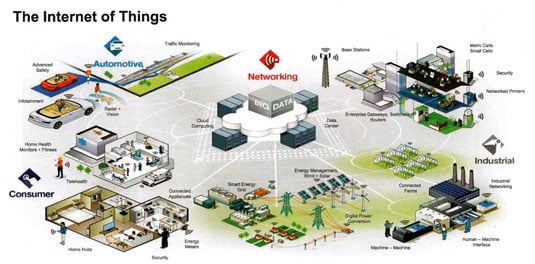Original URL: https://www.theregister.com/2014/05/07/freescale_internet_of_things/
Freescale: Cloudy dumb sensors? Nope, not OUR smart Internet of Things
Vehicle-to-X is next big digital gold rush – plus security and privacy, of course
Posted in Channel, 7th May 2014 09:04 GMT
Wearable devices are great examples of accessible stuff within the Internet of Things, but on the whole they’re pretty dumb sensors.
Typically, they use Bluetooth to crank out information to a mobile or similar gadget, which relays the data for processing in the cloud and then back to a web interface. Wearables are clever, but soon act dumb when the supporting connectivity disappears.
At the Future World Symposium in London last week, high on the agenda was the notion of Connected Intelligence, which goes beyond simply sensing, connecting and reporting. The general consensus at the event was that for Internet of Things (IoT) to really make an impression on the way we live, these devices need to be able to process data independently and be more than a remote sensor, but an Intelligent Node.
In his talk on Connected Intelligence, Bringing the IoT to Life, Steve Wainwright, chipmaker Freescale veep and general manager of EMEA, outlined the challenges. He spoke not only of his company’s plans in the automotive industry but for the growth and potential for semiconductor manufacturers gearing up for the Internet of Things.
"If you think about home automation, a lot of those individual applications have been around for years and if you’ve been selling micro-controllers for years, you know many of them very well," he said.
"You know about the security side, you know even about the smart energy side. All of a sudden the connectivity dimension of that changes it so dramatically and brand new industries get born as a result.
"At Freescale, networking is a long legacy application that we’ve understood very well, so this gives us some fairly unique features in terms of breadth in this space. For us connected intelligence talks about the technology that’s really enabling the IoT. It’s the sensing, it’s the connectivity, it’s the embedding processing.
"So if the Internet of Things is the conceptual model, the connected intelligence is really the model that enables it, hopefully, seamlessly and scalably. The other thing you get into with these three blocks of sensing, connectivity and embedded processing is really this opportunity to develop the Intelligent Node.”
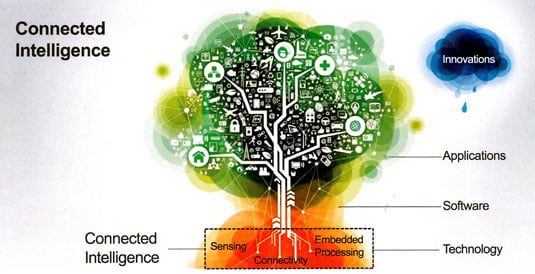
Connected Intelligence: going beyond sensing to decision making within the device
Although Wainwright recognises that Big Data has an important part to play in the Internet of Things, his focus is on the device itself. As an Intelligent Node it should be capable of managing the processing and working out whether or not to transmit that data anywhere else. To localise the processing has a number of advantages, one of which is perhaps all too easily taken for granted – the networking itself.
Data management
Reeling off some stats, Wainwright claimed that 2008 that was a significant year as the number of connected devices went above the number of people on the planet. The figure today is said to be 7.6bn items, with the most popular projection for 2020 hitting 50bn connected devices. And that’s just the connected devices; how many sensors is that?
"One of the real dangers of this is how on Earth do we manage these networks?" asked Wainwright.
"I think that the idea of connected or intelligent nodes that can handle things close to the edge of the network is tremendously important because that’s going to offload some of that network congestion and network complexity."
"That’s a real opportunity that we all should be aware of and thinking about, certainly in the semiconductor business, because this is the area for integration and for proliferating the technology into all layers.”
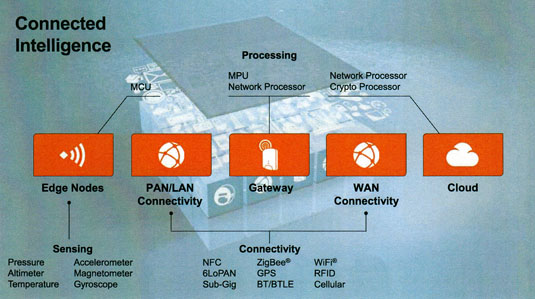
Compatibility is king? Connected Intelligence networking has a lot of different protocols to play with
So while connectivity is important, considerations for limiting what goes out to the network is going to have increased significance as each year passes. Also the intelligent node’s capacity to process incoming network instructions, to enable two-way traffic, as well as functioning autonomously are critical to advancing the usefulness of devices precipitating the Internet of Things.
The method of connectivity is another matter which Wainwright describes as a bit like alphabet spaghetti.
“You’ve got every possible portfolio known to Man; everybody competing for what’s the protocol going to be. The answer, from our point of view, is you have to be able to handle everything that’s thrown at you. You always find applications that have got different requirements, whether it be Sub-Gig, Bluetooth Low Energy and really, this is one of the big complexities that we have.”
Rip up your data centre blueprints
Admittedly, Freescale would want to highlight its capacity to support different networking protocols, and goes further by taking a swipe at the x86 architecture. Wainwright predicts a re-engineering of data centres with different breeds of processors emerging to accommodate the flow of information from the Internet of Things.
“One of the things that’s interesting about the Internet of Things is: does anybody really care any more about which processor architecture is out there? Does anybody care if it’s MIPS, ARM or x86? Certainly in the world of ARM, the opportunity with this explosive data requirement is really being seen as a way to break the x86 monopoly that’s existed there forever really in IT applications.”
That’s not all wishful thinking either, as the low power consumption of ARM processors is gaining traction with the likes of AMD and Dell, among others, developing their own ARM server ecosystems.
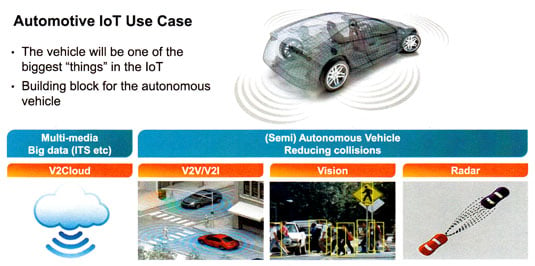
Freescale Connected Intelligence automotive
Back in the Freescale heartland of automative chips, Wainwright talked of V2Cloud (vehicle to cloud), V2V (vehicle to vehicle), V2I (vehicle to infrastructure) as examples of IoT in transport. Multimedia V2Cloud services are already in place, with audio and video streamed into cars. Services such as traffic management, under the umbrella of the Intelligent Transportation System (ITS), also form part of the vehicle-to-cloud experience, with some tasks relying on Big Data to manage navigation, traffic news and control.
Yet it’s the opportunity for vehicle-to-vehicle and vehicle-to-infrastructure transportation that has really got this business excited. These two approaches are set to unfold into semi-autonomous and, eventually, fully autonomous driving. Wainwright outlined latency and redundancy as among the technological challenges – but the biggest problem he could foresee had more to do with hot air than bits and chips.
Viennese whirl
Legislation and in particular the Vienna Convention on Road Traffic (1968) he singled out as “the classic gotcha for autonomous driving”. One of the issues here being that the driver must always be in control of the vehicle – this appears in Article 8 of the convention along with other similar criteria [PDF here]. However, Wainwright is optimistic that the court of public opinion will eventually enable suitable amendments as the advantages reveal themselves.
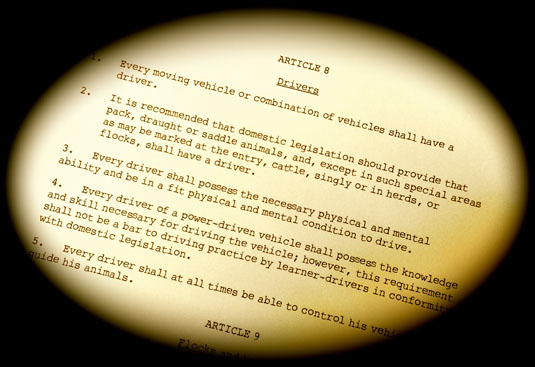
The rules of the road, 1968-style
"That fact that there is a big liability issue tends to go away when you’re used to using utilities that give you a real benefit as a person driving a car," he said.
"Self-park is the obvious one that’s already started – a pretty easy application. Platooning will be the next one, when you’re talking about high density traffic. As people get to the mode of wanting to avail themselves of these opportunities, I think the challenge will come from the sheer weight of adoption."
Beyond V2V and V2I there is vision and radar, with vision identifying signs, people, objects and other features – much like face recognition on tags on photos – and relaying it to a user interface or audible warning. Radar’s reach could benefit high speed driving or for navigating other hazards such as fog and, used together, vision and radar have great potential. It’s a set up that sees a dramatic increase in vehicle sensor technology controlled by central processing within the car and along with some connection to infrastructure.
The snag for this new age of transportation is dealing with the latency issues. There’s no point in having a radar in fog that tells you there’s a truck coming the other way that takes eight seconds to notify you when it’s six seconds to impact. Connected Intelligence might not seem so clever if it’s dogged by latency.
Security risks
There are other considerations which Wainwright laid out in his summary of Connected Intelligence entry requirements. Top of his list of four areas is Secure Data. He compared IoT security to the standard of UK restaurants, namely, rather hit and miss if you don’t know where to look.
“We have got some applications that are super-secure and very well engineered," Wainwright said. "However, the average level of security in IoT applications leaves a lot to be desired. I don’t think there’s anybody who wants to have a system and doesn’t really care about how secure their data is.”
Caring is one thing but awareness is another, and looking ahead he stressed security concerns with device manufacturers that make edge network products.
“Their ability to understand what happens to their data when it leaves them and goes via a network somewhere else is very questionable. What happens to your data downstream is an enormous topic to be understood. Think where all this data is coming from, where you’re sending it to and the potential for something to go wrong with that data. Privacy and security will be absolutely key issues.”
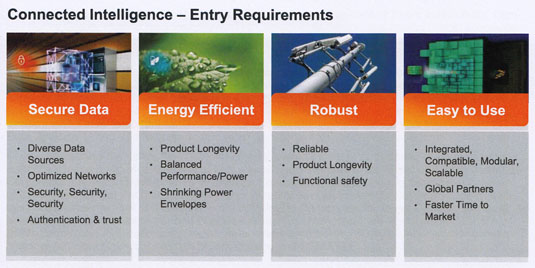
Connected Intelligence: entry requirements for the clever kit club
Parts for parts sake
Energy efficiency and robustness are the next two entry requirements, which are fairly self explanatory.
"I’m glad I’ve got automotive customers who really care about quality because these guys really drive you places you wouldn’t necessarily want to go yourself," Wainwright said.
"But in this market, if you think about some of the applications which are instal and forget that depend on a battery life for many years, that sort of zero PPM [number of defective parts per million] mentality is pretty important. It’s always a little demoralising when you actually manage to get very close to zero PPM and then your customer changes it to PPB [parts per billion], but it happens, you know."
The final item on the list of entry requirements for Connected Intelligence is ease of use. It’s perhaps surprising at this level, but Wainwright sees this as being vitally important to aid wider adoption as there are new customers out there as well as those that are adapting to the IoT side of existing sensor applications.
"If you think about the out-of-the-box experience that semiconductor suppliers have given with their processors, it’s dramatically changing. As we got in to much more complex graphics offerings, the expectation that people have that they could take our products and get them up and running quickly, was of a completely different order. The level of complexity that brought to us was really quite something.
"Although some are applications that we have understood for some time, they’re now changing rapidly. People who are dealing with the issues of connectivity and shrinking power envelopes and a graphics requirement are just not used to that. So there’s a massive demand for us to do a much better job of making these products stand for themselves and be usable."
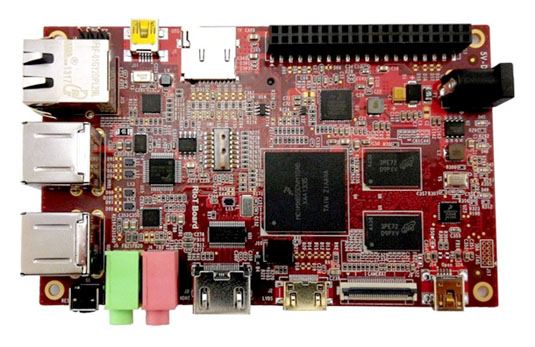
The RIoTboard: yet another obligatory low-cost learning platform
As part of this effort Freescale has teamed up with Element 14 to distribute the RIoTboard featuring a Freescale i.MX6Solo 1GHz ARM Cortex-A9 processor, costing £56. Making it affordable for developers has practical commercial considerations behind it all, as Wainwright emphasised.
"In general, if you’re going to be selling processors and micro-controllers at a dollar a go, you’d better be selling them on a pretty wide basis. So trying to make this technology broadly available is tremendously important," he said.
Keep it real
In closing, Wainwright remarked that although he believed there were enormous opportunities, he could also recognise similarities with the dot-com boom in the early 2000s and today's hype behind the Internet of Things.
“When you see massive acquisitions happening for companies with very little track record, very little product actually shipped, it doesn’t half remind me of 2001," he said.
"It worries me, but on the other hand this is grounded in technology that exists, so we’re in a different situation. We have a number of challenges that we need to face but the technology does exist and that’s a different thing.” ®
